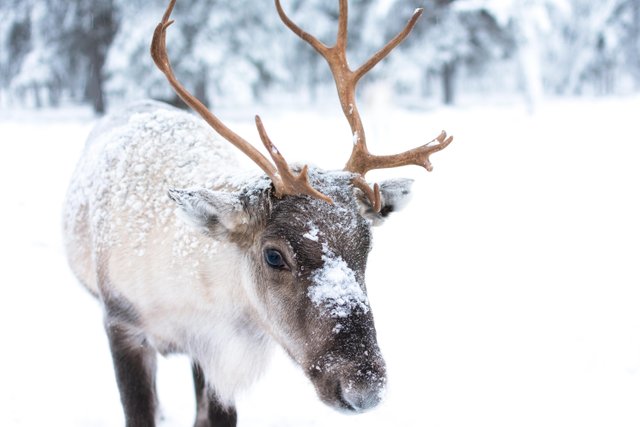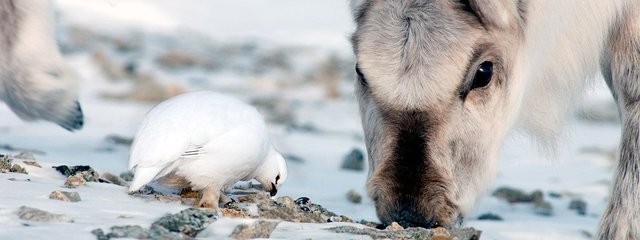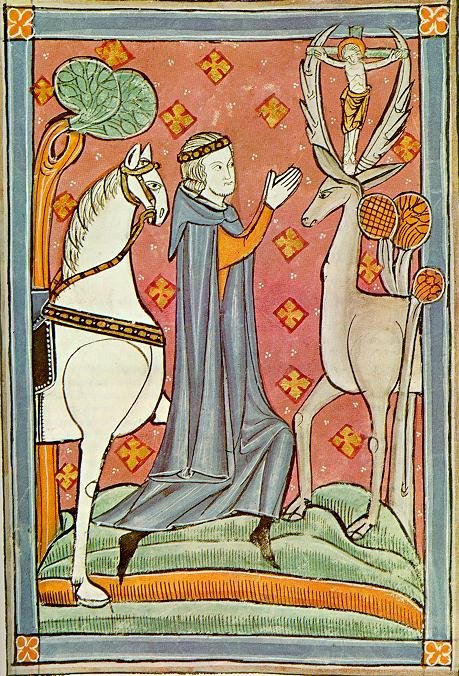Why Do Reindeer Fly? Holy Day 1; Contemplation on antlers and horns.
Why does Father Christmas use reindeer, and not, say, a horse, like his alter-ego Saint Nicholas (on his feast day of 5 December)? Or to make it more magical, yet, a unicorn? At least then we come close to giving the animals something in common: a decorative ornament upon their head!

Why making documentaries on reindeer is a pain!
[Reindeer come in all colours and sizes]View large on black
But ho, ho, ho! No, that's not the way to go about it. Neither the horn nor the antler is anything as funky as but a bit of glitzy headgear. It’s not a mere babe-puller! Let me show you how these extensions upon the skull are veritable antennaes - of two very distinct natures not to be interchanged. The horn listens to the transformative processes within. The antlers are pulled upwards, following the cosmic song, to cradle creative processes as inspired by cosmic (and angelic) forces.

Antlers are not horns. Indeed horns and antlers, substantially speaking are diametric opposites: hollow horn grows out of the skin (like nails), while antlers are bones - covered in skin/velvet. Horns are not shed, but antlers are (in the male) often to grow back with a new branch for each year the animal has matured. (Variations are species specific, in turn related to ecological variables.) This is an incredible tour du force! Costing large amounts of life-energy: for what purpose, one might well ask? Is this not a display of sheer vanity par excellence! How does that fit into the humble picture of Jesus in a manger surrounded by the lowly ox and the beast of burden that is the donkey?
There is a simple biological way to look at it, as in this blog: Why do reindeer shed their antlers. And there is a fitting esoteric meditation which I will share with you.
Horns are built up externally, cladding as it were, as is typical of the skin. In a spiralling motion, layer upon layer of silica is aspiring inwards - to resound the activity of the dreaming will-forces. It is the solar-panels of silica that also draw in the cosmic forces of air and light, to moderate the telluric activity of the moist, heavy cow.
Without this channelling instrument of the horns the cow's huge inner cavern of metabolic processes, the work in the cauldron where an alchemical miracle takes place - as the tough, fibrous green is turned by a mysterious recipe creamy, dreamy white - is condemned to a mute darkness. The cow without horns would be literally working in the dark, guessing the rhythm required, on an old programme, like a deaf drummer. This does nothing to enliven and make wholesome our milk. Hereby, a plea to all dairy farmers, to stop injuring their cows and debasing the quality of our milk and leave the horns in tact. More on bio-dynamic - Demeter - milk in Australia, e.g. here.
Pause for a moment to consider how the milk drinkers amongst us are all babes of mother cow. She gave birth to one calf and went on producing milk for all us human. Talk about compassionate sacrifice! It is a dark stain on humanity how we treat our cattle as if they are only and already slabs of dead meat on polystyrene dishes, or robotic slaves attached to breast pumps. Sensitive seers can detect an entirely different narrative for the cow. For a highly esoteric (clairvoyant) insight (of some repute), consult the Flensburger Hefte, series: "Gespräche mit Tieren" (No.3 for reindeer) and this article by Weirauch on-line for the cow.
Back to skin and bone. Bone is the most hightly developed organ in the animal kingdom. Not all animals have bones (from fish upwards, amphibians, reptiles, etc, but that is still a tiny percentage of all our fauna). Bones develp from the inner impulse to expand and explore more of the outer world. There is a vertical quality in their expression. Where this (incarnational) quality is lacking we find rickets and other ossary deformations, including bad backs. The degree or depth or incarnation (or groundedness to earth) is also visible in the quality of the bones. Per species of animal this varies. And in man we see clear differences indicating different levels of incarnation. Children have "springy", thinner bones, athletes have thick, hardened ones and the elderly's turn brittle. There is something cyclical, or bio-rhythmical expressed in the bone, which is accentuated by the regrowth and shedding annually of the antlers.
The horn has a more preservative gesture, as we saw in how it adds on substance of life, year by year. It also literally acts like a skin does on a drum: it resounds the metabolic music from within. With her horns the cow enjoys the alchemical transformations she is able to perform, and hearing she regulates - potentising with cosmic-etheric rhythms, unless we deafen her by sawing them off.
The spiral of the horn formation is a centripetal one, moving around the central core, hugging the bone of the inner self, as it were. A skin, indeed, is a sheath meant to protect and preserve the integrity of the whole body, with a barrier function. With its sense of touch it reaches without and brings to the heart. It takes the temperature of what is beyond its own limits, regulating and tempering in response. Without skin we'd be all over the place and have no sense of self. Think of the cat's whiskers and the story of Rapunzel to meditate more on the function of skin, and hair and the quality of silica in general.
The antlers (a calcium story by contrast) grow outwards, branching to pierce the heavens, seeking beyond its (heavy, material) self for new light-inspiration. It seeks spiritual impulses which inspire life forms (built up from elementary particles or natural substances). The deer's procreative cycle should illustrate this for you.
The deer family is able to delay embryological development, "pausing" the zygote after conception, which has taken place in October or November, to begins its proper development around 24th or 25th December. These are the first longer days of light albeit the start of winter (which we associate with cold, darkness, inertia). The Christmas mood is all about celebrating the inner light and warmth that is the sun working through the earth (instead of upon it). All things buried in the earth, roots and bulbs, and hibernating creatures retain a living warmth that sustains their dreaming existence. Nothing is quite dead except the surface of things.... The cosmic spirit is what lives. This is the entire crux of the Christ story.
Anyway, back to the pregnant doe. She is involved in a highly light-filled creative activity while gestating a rather fast-growing embryo, exactly when nature herself is not very forthcoming in material substances, during the winter months. The deer manages largely on cosmic forces, for which she retains her antlers. They serve as a kind of womb for the etheric (growth forces).
The male becomes creative after the birth of the fawn. A rush of blood upflows in the reconstruction of this tiered spire to heaven in his antlers. It lifts like a song from the heart to pull down new regenerative forces (preparing for the mating season).
Study the reindeer or the stag which is so often associate with the Christ in Medieval art.

St.Hubert
This is the direction in which our spirit should soar in the depths of winter, in search of ever-regenerative forces: that is the gesture of reindeer with their antlers (which technically they should not be showing this time of year, when male; so only females on F.C's pay role!).
Now you know why we have come to imagine reindeer in flight. It's a very old way of seeing, really. May that jolly your Christmas spirit along!

If you need to get in touch with the real deal, i.e. F.C. himself go here
Interesting post Sukhasana! I once received channeled information about the importance of cows, how they receive and transmit cosmic energy from the Pleiades. Their horns must play an important role in this